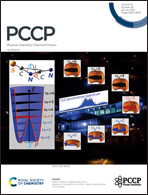Investigation of thermal control in phase-changing ABO3 perovskites via first-principles predictions: general mechanism of solar absorptivity†
Abstract
The fundamental mechanism of solar absorbance during the phase-change process is investigated in ABO3 perovskites based on first-principles predictions. A Gaussian-like relationship between the solar absorbance and band gaps is established, which follows the Shockley–Queisser limiting efficiency. For ABO3 perovskites with bandgaps of Eg > 3.5 eV, a low solar absorbance is obtained, whereas a high solar absorbance is obtained for ABO3 perovskites, with band gaps ranging from 0.25 to 2.2 eV. The relationship between the orbital character of the density of states (DOS) and the absorption spectra reveals that ABO3 perovskites with magnetic (strongly interacting) and distorted crystal structures always exhibit a higher solar absorptivity. In contrast, non-magnetic and cubic ABO3 perovskites always exhibit a lower solar absorptivity. Moreover, the tunable solar absorptivity always undergoes a phase change from cubic to large distorted crystal structures in ABO3 perovskites with strong interactions. These results can be attributed to a rich structural, electronic, and magnetic phase diagram resulting from the strong interplay between the lattice, spin, and orbital degrees of freedom, which induce highly tunable optical characteristics in the phase-change process. The findings presented in this study are critical for the development of ABO3 perovskite-based smart thermal control materials in the spacecraft field.



 Please wait while we load your content...
Please wait while we load your content...